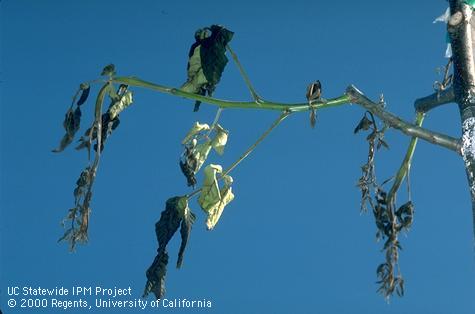Cold damage to walnut occurs mostly at locations away from the coast.
Identification
Late-spring frost can blacken and kill flowers, leaves, and shoots. Frost injury to young nuts causes the pellicle (skin) to turn black; this appears as a black ring if injured nuts are cut in cross-section. Early-fall frost can kill shoots and damage kernels. Damaged kernels darken, develop an unpleasant flavor, and decompose more rapidly. The terminal growth, particularly of young trees, may be killed during winter freezes. Such injured trees fail to leaf out normally in the spring and new shoots grow profusely below the dieback.

Disorder Development
Frost and freezing produce the same damage but occur under different conditions. Freezing occurs when air temperatures are 32°F or colder. Frost occurs when air is warmer than 32°F but plant tissues drop to 32°F or below because plants radiate (lose) heat into the atmosphere, especially during cool, clear nights.
The extent of cold damage depends partly on the temperature and the physiological state of the tree. Excessive vigor, mild fall temperatures, and late crop maturity can delay the onset of dormancy and increase the likelihood of injury if cold weather occurs. Walnut trees that are not fully dormant can be injured if temperatures drop abruptly to 22° to 28°F. Dormant trees can be injured by temperatures below 20°F.
Dry soil and the presence of a ground cover can increase the extent of cold damage. Firm soils that have recently been irrigated warm up readily during the day and radiate heat at night, keeping trees warmer.
Damage
Spring frost can kill flowers, leaves, and shoots. Early fall frost may damage kernels, leaves, and shoots. The terminal growth, particularly of young trees, may be killed during winter freezes. In the spring, new shoots grow profusely below the dieback, unless the trees were killed by the freeze.
Solutions
Keep any ground cover around trees mowed low. Irrigate dry soil several days before cold weather is expected. Adequate moisture in fall and winter lessens the potential adverse impact of frost and freezing. In a low-rainfall year, winter irrigation may be necessary to help protect trees from cold damage.
When a freeze or frost is predicted, if trees are small enough, covering them in the evening with blankets, frost cloths, or nonplastic tarps can help keep them warmer. Leave covers open at the bottom so heat from soil can radiate up and help warm the plants. Remove covers during the day.
If freezing weather is predicted, covering plants alone is of little help unless a heat source is provided. Placing incandescent lights designed for outdoor use in the canopy may generate enough heat to prevent the plants from freezing if the plants are also covered. Be sure not to create hazards of electrical shock or fire.
If trees are damaged by a frost or freeze, do not remove dead leaves or twigs until late spring or summer. Prune out dead parts only after new growth develops. Pruning too early may remove live branches and increase the risk of more damage. An exception is limbs or trunks that are hazards and may fall; these should be promptly removed.
References
Adapted from Integrated Pest Management for Walnuts Third Edition, University of California Statewide Integrated Pest Management Program (UC IPM).
